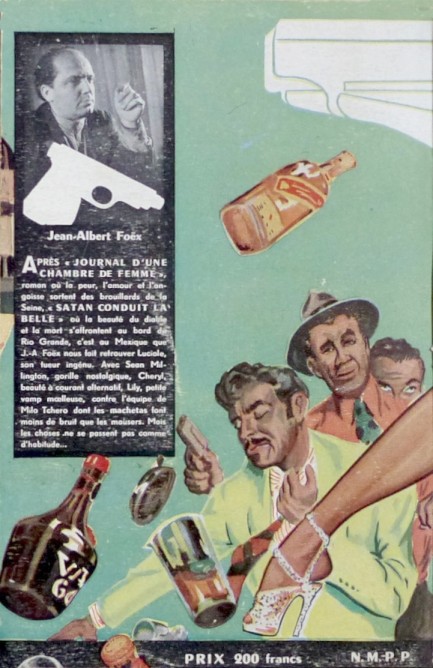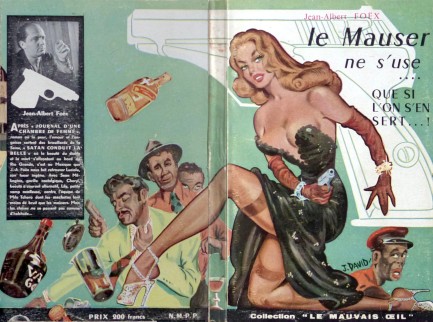 Colonials in South Africa experience a different type of rhythm and blues. 
South Pacific. South America. South of France. We don't care—we love books sets in exotic places wherever they might be. Tell It on the Drums takes readers to South Africa as five men attempt to escape with $250,000 in diamonds from a dusty mining town called Kimberley and reach Pretoria. The story is basically a western escape tale, set in the late 1800s, when places like the Orange Free State and Cape Colony still existed, and the law was something that could be outdistanced on the back of a good horse. Pursuit is inevitable, but paranoia too. And as you'd expect, the real problem is not the law but the fractious partnership between the quintet of fugitives, which includes fearsome U.S. Civil War rebel Adam, craven Boer mercenary Coenraad, and compulsive French thief Dénis.
The 24/7 throbbing of drums are intelligible to tribespeople, and relay news in rhythm about the robbery. The five fugitives are soon known throughout the land, as are their movements and deeds. They have an inkling reports of their heist have travelled by air, but still think they're escaping secretly. It's an illusion. Too bad none of them understand the drums, because they begin urging that the quintet be herded north for some mysterious purpose. Surprisingly, Krepps splits the group up at that point in the story. Coenraad and Dénis trek upcountry to trick tribesmen out of their riches. Adam and one other continue fleeing to Pretoria. The inside man-turned-unwilling accomplice bolts into the veldt but is taken on by a veteran hunter. All the while the drums say: north, send them north, and it's clear that a reckoning looms.
We'll stop there, but we want to note a great set piece—to steal a cinematic term—involving a mass charge by twenty enraged baboons. It's a centerpiece sequence, all teeth, fangs, gunsmoke, and blood, and it's well written. Krepps is a solid writer on all fronts. Tell It on the Drums moves quickly and there are no moments where the narrative falters or feels forced. All the usual warnings about mid-century literature set in Africa apply, but in this case Krepps gives South African tribespeople agency via his device of coded drum talk. Drums speak in most novels of this type, but this time they're in all places at all times, surrounding the white men, and seem to be the entity in control. It adds a nice layer of dread. Overall, an excellent book, with nice cover art by Robert Stanley.
 Harlem hath no fury like a righteous man scorned.  
This Japanese poster for the 1990s period crime drama A Rage in Harlem happened to catch our eye, partly because the art by Joe Batchelor is great, but also because we knew the American promo featured not this painting but a rather banal group photo of the cast. We don't know why Japan got the better promo, but we can speculate. By this time global audiences were acclimated to photographic promo art, but in Japan the cast—Forest Whitaker, Robin Givens, and several established actors of the period—were unknown to local filmgoers, so the distributors marketed the movie as an art film, a sort of exotic trip to 1950s Harlem. The text on the poster's reverse seems to confirm that: 1956, Harlem. Jazz clubs, dancehall dresses, and people in suits, with a nightlife unfolding in a Harlem-style destination.
Chester Himes' novel For Love of Imabelle provided the source material, and it features everything the poster promises. The story deals with a naive and religious young Harlem undertaker played by Whitaker who's taken in by scam artists, tries to retrieve his money, but runs into an array of complications, some of them comical, most of them lethal. The movie follows the book pretty closely, which means it's bound to have good moments, but the direction by Bill Duke is a bit ponderous in the early stages, the script's many interjections of humor lack the zest of Himes' writing, the soundtrack is often a mismatch of mood, and the entire production suffers from budgetary constraints. It wasn't shot in New York City, but rather Cincinnati. While architecturally that made sense because Cincinnati has scores of brownstone houses in the style of old Harlem, there's really no substitute for the Big Apple.
On the plus side, the cast is interesting. Whitaker would later become a respected Hollywood figure, though here he's a little green, still feeling his way as an actor. Danny Glover, Bajda Djola, and Gregory Hines are entertaining in supporting roles. Givens fits the part of a femme fatale like a glove—which is to say, she's slinky as hell and startlingly beautiful. And turning back to the setting, while, as we said, Cincinnati is no Harlem, the many brownstone apartment houses did create a workable backdrop, and Duke uses the city in every advantageous manner he can manage. These are enough attractions, we think, to push the movie onto the plus side of the ledger. After its 1991 U.S. run A Rage in Harlem reached Japan in 1992. The rear of the poster gives a premiere date of May 2.
                  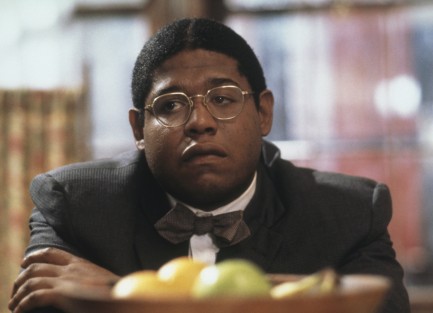  
 I got shit here that'll blow your minds. Dented saucepans, frayed towels, old keys. I'm talking grade-a junk. 
Robert W. Taylor's 1954 novel The Junk Pusher is one of numerous mid-century drug scare books. Many of them deal in an unintentionally hilarious way with marijuana. This one, though, is about heroin, and we think Taylor is on safe ground here in saying it can be very dangerous. The cover art is by Frank Cozzarelli, who we've seen around these parts before. Check here.
 The whole world sings with her—except Bogart. 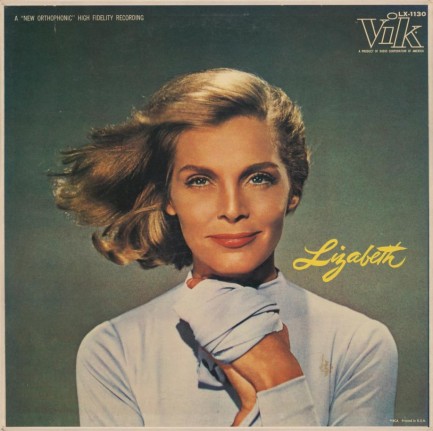
The first time we saw Lizabeth Scott sing was in the film noir Dead Reckoning, in which she starred with Humphrey Bogart. Scott breaks into a little torch number while they're at dinner. Old fims, including old noirs, often required female leads to sing, but having Scott sing at the table was a twist. Unlike the normal set-up in which the actress sings onstage sa a performer in a nightclub or casino, it was closer to the technique that would become standard in musicals, with the song flowing directly from the dialogue. Bogart mostly seemed baffled, possibly even spooked. You can see what we mean here.
We realized only recently that Scott, backed by Henri René and His Orchestra, released this 1958 album on RCA. She has a somewhat smoky speaking voice, so we were intrigued by the possibilities of an album. She performs such classics as “I'm in Love Again,” and “When a Woman Loves a Man,” and her vocal instrument is really nice, residing in the deep and mellow mode. If you like orchestral pop music you'll probably like the record. Give her a listen here and here, while the links last.
 It's the old love triangle: man, woman, and liquor. 
Charles Willeford's 1956 novel Pick-Up is fronted by the work of Frank Uppwall, who we've featured here once before. We've featured a bit more of Willeford. In this one a down-on-his-luck San Francisco diner counterman named Harry Jordan meets a down-on-her-luck customer named Helen Meredith and sparks fly. Also flying in short order are emotional turmoil, tears and regrets, and unsound life choices. The duo mostly drink and dream. They fall into a mutual depression. They make a suicide pact but fail in their wrist-slashing attempt to shuffle off this mortal coil. They check themselves into a hospital for mental care but manifest no discernible benefits. Finally they return to their downward spirals of alcoholic self-medication. The story is a bit like a noirish Days of Wine and Roses, as Harry is able to keep a grip on his drinking but Helen isn't. When you reach the end you'll go, "Huh?" and wonder whether you should read the entire thing again. It's a black tale. Willeford might not be the best writer, but his ideas are definitely unique.
 Oh, big deal. I have one too. It even lights cigarettes. 
The above image of what appears to be a low intensity armed standoff was made to promote the 1965 Cold War spy flick The Ipcress File, which we hear is one of the more interesting films from a teeming genre. The photo shows Sue Lloyd, who appeared in about twenty-five films, including Revenge of the Pink Panther, No. 1 of the Secret Service, and the Joan Collins vehicles The Stud and The Bitch. The Ipcress File was headlined by Michael Caine, which makes it a mandatory watch. We'll do that at some point. We have another Lloyd promo from the film below.
 Joan is in her sweet spot with a challenging film role. 
How do you judge a great acting performance? One way is when beforehand you look at the performer and the part and say, “Impossible, doesn't fit, can't possibly work,” then it does. Flamingo Road, which premiered in the U.S today in 1949, features Joan Crawford as a carny performer and it doesn't fit. But probably nobody would seem to fit. The main character evolves over years from carny chippie into upper crust lady, so either way a filmmaker would have to make a difficult choice—cast an ingenue who evolves into a sophisticated middle-aged woman, or cast a mature actress and hope she can play young. They chose the later option with Crawford, and it can't possibly work. But this is Crawford we're talking about—she could make most any role work, and does so here with a typically assured performance.
Flamingo Road is set in the American south and is about the social mores and political machinations of a small but wealthy town. The title refers to the enclave where the rich and powerful live together in their mansions and manors. The carny version of Crawford falls for local deputy sherrif Zachary Scott, but he's been tabbed by local kingpin Sydney Greenstreet to be his puppet in the state senate. As part of that plan Scott is to marry into wealth. Cavorting with a carny isn't going to fly. Greenstreet decides to break them up, or hurt Crawford trying, and there's nothing so underhanded or injurious that he won't do it. Crawford, though, is tougher than anyone expects, and what she learns from her travails is, first: she's going to make it to Flamingo Road no matter what it takes; and second: she will have her revenge. That's all we'll tell you about the plot.
Flamingo Road is another of those movies that's often called a film noir, and while we don't try to be gatekeepers of what is and isn't noir—because we have no authority to do so—we also don't avoid stating the obvious. Flamingo Road isn't a film noir. Some entities, including respected ones, have a vested interest in casting the noir net as widely as possible. If you host noir festivals, for example, after a while you need to expand your defintion of noir to keep your slate fresh. If you write film noir books, you might want to demonstrate that you think outside the box by including Chinatown or Lat sau san taam or The Limey (all excellent movies, by the way).
At the opposite extreme, several prominent critics attest that film noir doesn't exist at all. That's like saying there's no such thing as superhero movies because costumed heroes are just further iterations of superpowered characters such as Rambo. Superhero movies exist. So does film noir, though it resides within the wider genres of crime and drama. However, it's too easy to call any movie with conflict and a few neon-splashed night sequences a noir. Film noir is as much thematic as it is iconographic. In every way that we can discern, Flamingo Road isn't one. The definitive American Film Institute calls it a melodrama. We agree. It's a melodrama in which a good actress, aged north of forty, overcomes difficult casting to knock her years-spanning role out of the park.
            
 Gun goes bang-bang, problem goes bye-bye. 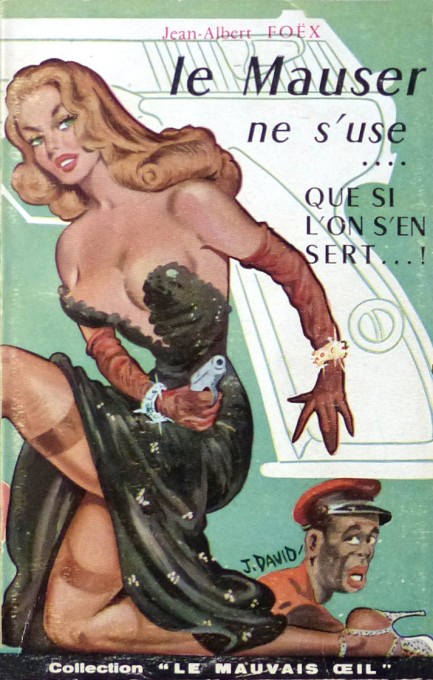
Above is a cover for Jean-Albert Foëx's 1954 crime novel Le Mauser ne s'use que si l'on s'en sert..! painted by French illustrator Jean David, whose work we've shown you before, notably here and at the bottom of this collection. We aren't happy with David's visual treatment of the black character at the lower right, but you can't doubt his technical proficiency. This book, the title of which translates to, “the Mauser only wears out if you use it,” deals with a supervillain named Luciole who gets up to no good in Mexico and is soon pitted against protagonist Milo Tchero and his crack team of sidekicks. We gather these are recurring characters but we don't know how many appearances they made. The publisher here, E.D.I.C.A., liked wraparound covers, as you can see on an example we shared a while back. Jean David will return.
 Every top notch private investigator knows the best clues are found in bed. 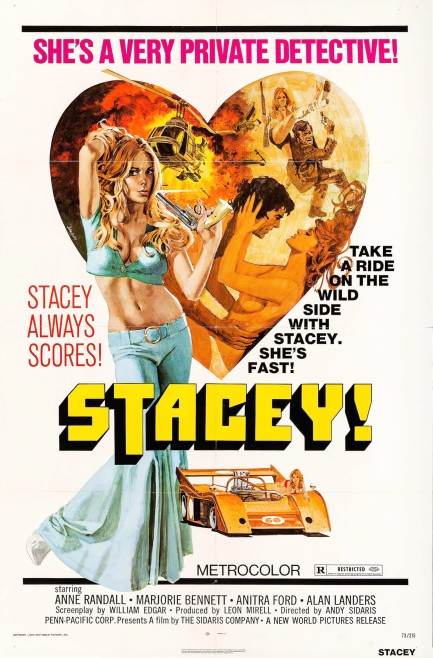
We wanted to show you another poster painted by John Solie, who was responsible for numerous blaxploitation, sexploitation, and action promos, all executed at the extremely high level you see here with his one sheet for Stacey. His other notable efforts include those for The Arena, Star Crash, Hit Man, and Hollywood Boulevard. You can click his keywords at bottom to see everything we've shared from him.
Naturally we watched Stacey and it's a cheesy detective tale starring erstwhile Playboy centerfold Anne Randall, who plays a model-turned-private dick hired to investigate a rich woman's extended family before any of them are allowed to be included in her will. Randall arrives just in time for intrigue and murder. Private investigators need to possess a Class C license in order to legally take on clients. The C on Randall's license probably stands for “casual sex.”
Even so, there's not much here. The detective elements are uninspiring despite a noir style voiceover, and the sexual elements, even with Randall and co-star Anitra Ford in occasional undress, are not going to blow your skirt up. To put the overall nothingness of the movie in perspective, consider the fact that we couldn't find a copy with sharp enough resolution to make screenshots worthwhile, nor enough official production photos to make them worth sharing. That's how much of a historical afterthought it is.
In lieu of imagery you could use your imagination, but we recommend not bothering. Stacey resides at the low end of grindhouse cinema characterized by numerous bold and outrageous entries. In our opinion it's notable only for being the first exploitation effort by director Andy Sidaris, who would go on to helm boobalicious ’80s throwaways such as Malibu Express, Hard Ticket to Hawaii, and Savage Beach. Stacey premiered in the U.S. this month in 1973.
 My husband is clueless. He suspects I'm having an affair, but he thinks it's with a guy from his softball team. 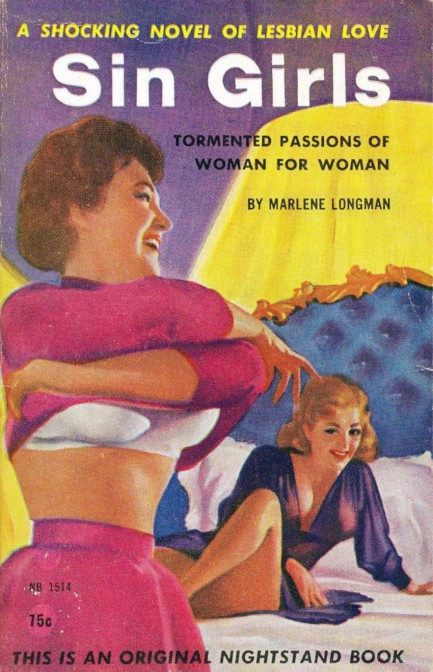
Above: a nice sleaze cover from Greenleaf Classics' Nightstand imprint for 1960's lesbian novel Sin Girls by Marlene Longman. This has the look of a photo-illustration, but it's credited to Harold W. McCauley.

|
 |

The headlines that mattered yesteryear.
2003—Suzy Parker Dies
American model and actress Suzy Parker, who appeared the films Funny Face and Kiss Them for Me, was the first model to earn more than $100,000 a year, and who was a favorite target of the mid-century tabloids, dies at home in Montecito, California, surrounded by family friends, after electing to discontinue dialysis treatments. 1920—Negro National Baseball League Debuts
The first game of Negro National League baseball is played in Indianapolis, Indiana. The league, one of several that would be formed, was composed of The Chicago American Giants, The Detroit Stars, The Kansas City Monarchs, The Indianapolis ABCs, The St. Louis Giants, The Cuban Stars, The Dayton Marcos, and The Chicago Giants. 1955—Williams Wins Pulitzer
American playwright Tennessee Williams wins the Pulitzer Prize for Drama for his controversial play Cat on a Hot Tin Roof, which tells the story of a southern family in crisis, explicitly deals with alcoholism, and contains a veiled subtext concerning homosexuality in southern society. In 1958 the play becomes a motion picture starring Elizabeth Taylor and Paul Newman. 1945—Germany Announces Hitler's Death
German radio in Hamburg announces that Adolf Hitler was killed in Berlin, stating specifically that he had fallen at his command post in the Reich Chancery fighting to the last breath against Bolshevism and for Germany. But in truth Hitler had committed suicide along with his mistress Eva Braun, and both bodies were immediately thereafter burned. 1960—Powers Is Shot Down over U.S.S.R.
Francis Gary Powers, flying in a Lockheed U-2 spy plane, is shot down over the Soviet Union. The U.S. denies the plane's purpose and mission, but is later forced to admit its role as a covert surveillance aircraft when the Soviet government produces its remains and reveals Powers, who had survived the shoot down. The incident triggers a major diplomatic crisis between the U.S. and U.S.S.R.
|

|
|

It's easy. We have an uploader that makes it a snap. Use it to submit your art, text, header, and subhead. Your post can be funny, serious, or anything in between, as long as it's vintage pulp. You'll get a byline and experience the fleeting pride of free authorship. We'll edit your post for typos, but the rest is up to you. Click here to give us your best shot.

|
|





















































